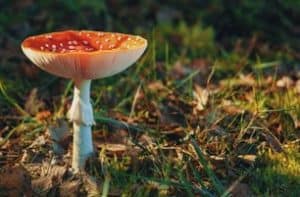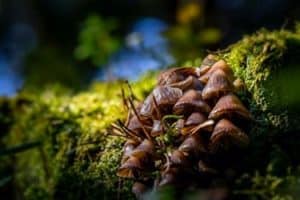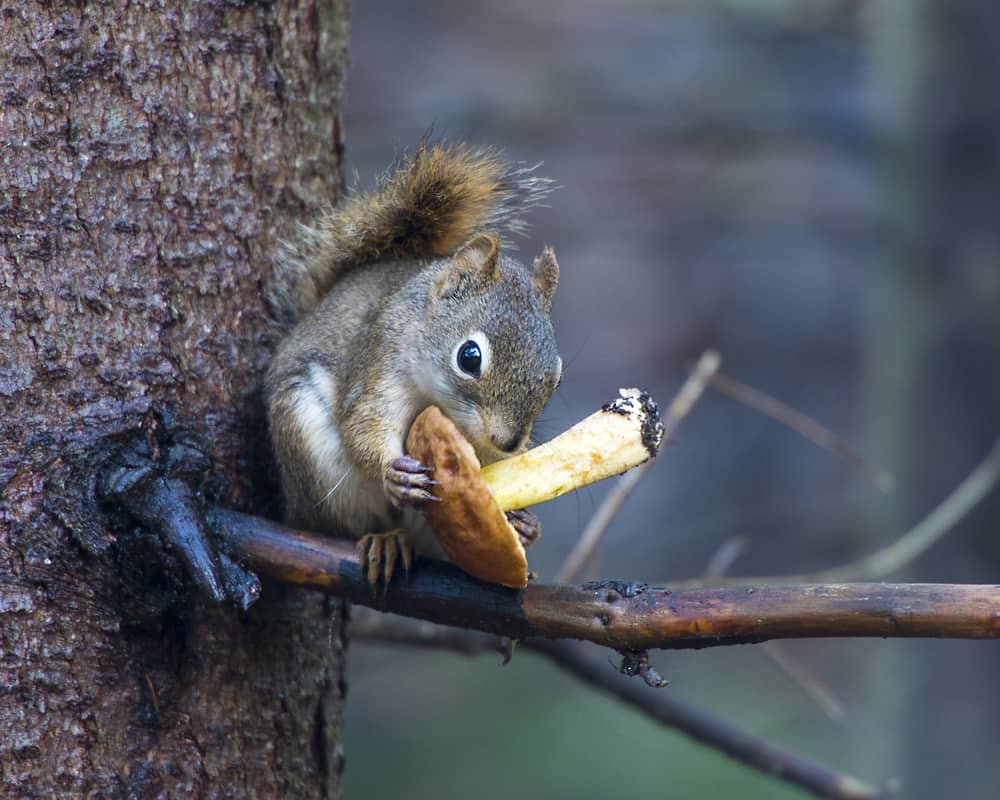What Animals Eat Mushrooms & How Do They Know Which Ones Are Safe?

As the seasons change, so do the sources of food in a forest ecosystem. A multitude of animals eats fruits, berries, and nuts, typically found on the forest floor. Nevertheless, they also enjoy a highly nutritious food source; fungi. In this guide, we’ll answer one of the commonly asked questions, ‘what animals eat mushrooms?’ and how they avoid consuming the poisonous ones. Read on!
What Animals Eat Mushrooms?
Let’s discuss the animals the devour mushrooms and the types they enjoy.
1. Pigs
They are known for being naturally gravitating towards mushrooms due to their powerful sense of smell and the ability to quickly identify the smell of truffles. The subtle aroma that truffles emanate lures in pigs, which is why they are usually used to hunt wild truffles.
Nevertheless, wrestling the truffle from a pig’s mouth remains a challenge. Those who know how to forage mushrooms use pigs to pinpoint the location of the truffles after which they are harvested.
Besides truffles, pigs consume various types of mushrooms. Due to their omnivorous nature, pigs can eat all types of foods that humans consume. Therefore, mushrooms, including the grocery-store types, are food items that pigs can devour.
If you’re a pig owner who plans to incorporate mushrooms into your pigs’ diet, then we recommend feeding them Porcini, Portobello, Morel, White Button, Cremini, Black trumpet, or Oyster mushrooms.
It’s worth keeping in mind that free-range mushroom species can be poisonous, given that 20% of wild mushrooms are unfit for consumption. Contrarily, mushrooms are loaded with minerals such as zinc, potassium, magnesium, copper, and the B vitamins, including niacin, riboflavin, and pantothenic acid.
The combination of these minerals and vitamins boost immunity, enhance the performance of the red blood cells, elevate the digestive system, and prevent degenerative diseases.
2. Bears
They are known to eat various types of fungi, including mushrooms. As omnivores, bears can be on meat-based and plant-based diets. While they can hunt, bears also eat readily available food in the forest, including mushrooms. For instance, they usually consume mushroom species to supplement their diet of animal-based and plant-based food.
Every year when summer rolls around, black bears particularly are drawn to eating mushrooms. That’s because the lack of good nutrition during winter, spring, and fall cause them to lose weight which must be regained. New plant growth also ushers in that of mushrooms. As a result, black bears begin foraging for these mushrooms.
Similarly, these animals eat fungi to supplement their diet and make-up for the weight they lost. Rich in magnesium, zinc, calcium, and protein, mushrooms aid in the growth of their bones coupled with the strength of their muscles.
3. Squirrels
These small creatures enjoy eating mushrooms as they aid in bone growth and strength. Squirrels are herbivorous, which means it’s a no-brainer that they consume plant-based food sources. You’ll notice them nibbling on nuts, plant stalks, and roots.
Although being on a plant-based diet means they can eat mushrooms, if you have a squirrel as a pet and want to incorporate these fungi into its diet, we recommend consulting your vet on the mushroom species that are safe for their consumption. After all, the last thing you need is accidentally feeding your beloved fury friend a poisonous mushroom.
In the wild, squirrels are known to hunt for mushroom species as they are incredible foragers. They quickly spot poisonous mushrooms and instinctively avoid them. Mushrooms can provide squirrels with important nutrients that their bodies require due to the high levels of niacin, thiamine, calcium, riboflavin, and magnesium.
When exploring the great outdoors, you’re likely to stumble upon gray and red squirrels eating mushrooms. They’ll instinctively steer clear of death cap mushrooms and toadstools as they are poisonous and could result in a fatality if consumed. However, they’ll gobble other edible mushrooms flourishing in the wild.
4. Deer
These are herbivorous and will eat plant-based food sources. Since deer are also known to hunt for plants, they can easily identify the various types of food based on the shape, smell, and color. For instance, deer can instinctively differentiate the smell between various types of fruits and vegetables. Their strong sense of smell also allows them to quickly pinpoint the location of various edible mushroom species.
Amongst most deer species, the Whitetail quickly identifies the mushroom species that flourish in moist conditions. When summer rolls around right after spring, forests that receive heavy rainfall will be peppered with mushrooms. Deer can forage the mushrooms and are drawn to the strong smell of the fungi. One of the reasons deer should feed on edible mushroom species is the high nutritional value of the fungi.
Like bears, deer also lose weight during winter, making it important to make up for the loss. The high nutritional value of the mushroom species will supplement the weight loss and provide essential vitamins and minerals.

5. Slugs
You’ll find slugs eating mushrooms as this makes up their main food source. If you closely observe mushrooms around damp areas, you’ll see slugs feeding on them. That’s because mushrooms and slugs thrive in moist conditions with a particular level of foliage.
It’s not surprising that mushroom farmers face the problem of slugs eating their crops. If there’s a slug infestation, besides targeting edible mushroom species, they’ll also consume seedlings. In the wild, slugs are a necessity to prevent growth from getting out of hand.
However, when it comes to harvesting the mushrooms, slug control is necessary. They needed to be handled right off the bat as these mollusks multiply rapidly and can destroy a farmer’s entire produce overnight. What differentiates slugs from other mushroom-consuming animals is that they can also eat poisonous fungi with no repercussions.
6. Snails
Another mollusk that consumes fungi such as mushrooms is snails. While these creatures are mostly herbivorous, they must incorporate a sufficient amount of minerals and vitamins into their diet. To do so, they usually consume various types of fungi, one of which is mushrooms. Furthermore, snails must make sure their muscles develop enough to help them crawl on the ground.
Mushrooms contain high levels of calcium. Regular mushroom species that are eaten frequently have about 2.9mg of calcium per 100 grams. Therefore, snails require eating mushrooms to supplement the required for their optimal health and wellbeing.
Snails must eat a considerable quantity of calcium to make sure their shells are sturdy enough to offer sufficient protection, given that this is their only defense mechanism. Besides that, snails are usually found in moist environments and are layered with moss.
Furthermore, these conditions are also perfect for mushroom growth. Due to their herbivorous nature, snails gravitate towards the available mushroom species.
7. Goeldi Monkey
As a creature that revels in mushroom consumption, the Goeldi monkey is a small primate native to South American regions. Due to its herbivorous nature, the monkey is solely on a plant-based diet. Nonetheless, it’s customary to associate this creature with vegetables and fruits.
The Goeldi monkey has the uncanny ability to quickly spot edible mushroom species and eat them. They can intuitively differentiate the poisonous species from the non-poisonous ones. As part of the primate family, these monkeys have a complex muscular and nervous system. Therefore, their diet should include adequate vitamins, minerals, and proteins for optimal health and overall wellbeing.
The Goeldi monkeys usually supplement their diet with fungi and mushrooms to make sure they get their required dose of essential minerals and vitamins to get rid of nutritional deficit. Contrary to the Goeldi monkey, other monkey species don’t eat mushrooms frequently as they are not essential for their diet. They only opt for mushrooms in the absence of other food sources.
How Do Animals Know Which Mushrooms Are Safe?
Most animals, particularly those in the wild, have the perfect combination of training, instinct, and experience that prevents them from consuming poisonous mushrooms. Herbivorous animals in the wild, for instance, will consume particular plants rather than others. They learn from their parents and experience the edible mushroom species.
Additionally, some animals will nibble a piece of a plant and can tell by the off-putting bitter taste that it’s unfit for consumption. Other animals avoid particular mushrooms based on color combinations or particular colors.
It’s worth noting that domestic animals don’t share these same instincts, which means, they’ll consume nearly anything in their sight and within reach, such as socks, light bulbs, poisonous mushrooms, batteries, and fertilizer to chocolate, and everything in between that smells wonderful and edible.
While all of these can pose a health hazard (if not fatal), it doesn’t stop domestic animals from satisfying their curiosity by indulging in them.
To Wrap Up
These are only a few animals that instinctively eat mushrooms and other types of fungi to gain valuable energy and nutrients. While some wild creatures solely eat fungi, others consume it as part of their diet like humans.




